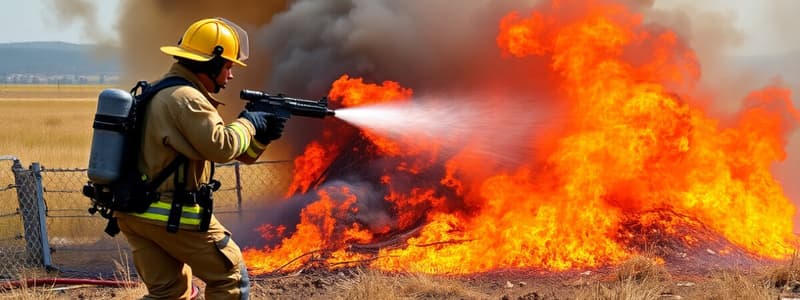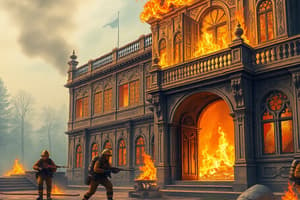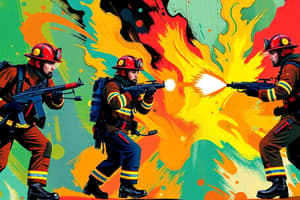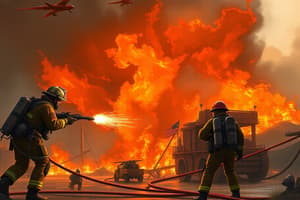Podcast
Questions and Answers
What is the primary focus of an Offensive Fire Attack?
What is the primary focus of an Offensive Fire Attack?
- Evacuation protocols
- Rescue operations (correct)
- Fire extinguishing tactics
- Structural integrity assessment
When initiating offensive operations at a structure fire, what must first be determined?
When initiating offensive operations at a structure fire, what must first be determined?
- Extent of fire damage
- Firefighter readiness
- Location of all exits
- Safety of entry (correct)
Which is a key guideline for offensive fire attacks?
Which is a key guideline for offensive fire attacks?
- Initiate fire operations within the first minute.
- Maximize water usage immediately.
- Focus solely on the fire rather than surroundings.
- Assign IRIC team prior to entry. (correct)
What should command consider regarding the speed of fire spread?
What should command consider regarding the speed of fire spread?
What is emphasized about evaluating fire conditions?
What is emphasized about evaluating fire conditions?
Why must command allocate personnel and resources based on fire spread evaluation?
Why must command allocate personnel and resources based on fire spread evaluation?
What must firefighters resist doing when approaching a fire?
What must firefighters resist doing when approaching a fire?
What ultimately must firefighters do according to the fireground reality?
What ultimately must firefighters do according to the fireground reality?
What is the primary objective when dealing with severe exposure during a fire incident?
What is the primary objective when dealing with severe exposure during a fire incident?
What does 'fire under control' signify in fire operations?
What does 'fire under control' signify in fire operations?
What are the seven sides of a fire that command must consider?
What are the seven sides of a fire that command must consider?
What must be done during attacks in concealed spaces to ensure success?
What must be done during attacks in concealed spaces to ensure success?
When should Command initiate a PAR report during a fire incident?
When should Command initiate a PAR report during a fire incident?
What action should be taken if defensive operations commence from the start of a fire?
What action should be taken if defensive operations commence from the start of a fire?
When is it appropriate to abandon a marginal attack?
When is it appropriate to abandon a marginal attack?
What is a key consideration for command regarding fire control operations?
What is a key consideration for command regarding fire control operations?
What is the most effective tactic to protect exposures in a fire when water is limited?
What is the most effective tactic to protect exposures in a fire when water is limited?
What is indicated by a marginal situation in firefighting?
What is indicated by a marginal situation in firefighting?
How should command prioritize operations in a fire scene?
How should command prioritize operations in a fire scene?
What factor must be continuously evaluated during an interior attack?
What factor must be continuously evaluated during an interior attack?
What are the two main strategies that can be used at structure fires?
What are the two main strategies that can be used at structure fires?
What action must be prioritized in concealed space fire attacks?
What action must be prioritized in concealed space fire attacks?
What aspect does the Incident Commander NOT consider when choosing a fireground strategy?
What aspect does the Incident Commander NOT consider when choosing a fireground strategy?
What is a critical responsibility of the Incident Commander during a fire incident?
What is a critical responsibility of the Incident Commander during a fire incident?
Why should simultaneous Offensive and Defensive strategies be avoided?
Why should simultaneous Offensive and Defensive strategies be avoided?
What must be included in the on-scene report by the initial Incident Commander?
What must be included in the on-scene report by the initial Incident Commander?
How should the Incident Commander approach monitoring the fireground strategy?
How should the Incident Commander approach monitoring the fireground strategy?
What type of benchmarks might influence a change in the fireground strategy?
What type of benchmarks might influence a change in the fireground strategy?
Which of these is NOT a factor in matching the strategy to fire conditions?
Which of these is NOT a factor in matching the strategy to fire conditions?
What is the primary reason Command should assign a Roof Sector during marginal situations?
What is the primary reason Command should assign a Roof Sector during marginal situations?
What constitutes a change to a defensive strategy in fireground operations?
What constitutes a change to a defensive strategy in fireground operations?
Which of the following actions is recommended when switching to a defensive strategy?
Which of the following actions is recommended when switching to a defensive strategy?
What is the first priority in defensive operations according to fireground strategy?
What is the first priority in defensive operations according to fireground strategy?
In the context of fire operations, what should happen if hose lines delay retreat and staying is unsafe?
In the context of fire operations, what should happen if hose lines delay retreat and staying is unsafe?
How should the announcement of a change to a defensive strategy be communicated?
How should the announcement of a change to a defensive strategy be communicated?
What must be completed after switching from an offensive to a defensive strategy?
What must be completed after switching from an offensive to a defensive strategy?
What should be done to address exposures during defensive operations?
What should be done to address exposures during defensive operations?
Flashcards are hidden until you start studying
Study Notes
Fireground Strategy
- The New Lenox Fire Protection District has two strategies for structure fires: Offensive and Defensive.
- The two strategies are based on a Risk Management Plan, and the Incident Commander chooses the proper strategy.
- The strategy can change based on conditions or achieving certain benchmarks.
- The Incident Commander's responsibility is to ensure all personnel operate within the chosen strategy, providing scene safety.
Factors for Determining Strategy
- Building Type: Construction, condition, and age are considered.
- Structural Integrity: Contents and structural involvement are assessed.
- Fire Load: Type of fuel burning and remaining fuel is evaluated.
- Fire and Smoke Conditions: Extent, location, and behavior are important factors.
- Rescue Profile: The potential for saving occupants and assessing their survivability.
Offensive Fire Attack
- The primary focus of an Offensive Fire Attack is rescue.
- The structure must be deemed safe for entry before initiating this approach.
- IRIC Team: An Immediate Response & Incident Command team are assigned prior to entry, according to established guidelines.
- Initial Attack: The initial attack line is deployed between victims and the fire, protecting escape routes.
- Fire Conditions: Determine fire conditions and extent before starting fire operations.
- Unburned Portion: Evaluate the unburned areas to predict fire spread and plan for fire control activities.
- Command Considerations:
- Rescue activities
- Risk to firefighters
- Confinement efforts
- Exposure protection
- Seven Sides: The fire should be considered from all seven sides (front, rear, both sides, top, bottom, and interior)
- Concealed Spaces: Addressing fires in concealed spaces (attics, ceiling voids) is crucial for early containment.
- Ventilation: Early ventilation in concealed spaces and fire areas is vital for containment.
- Fire Spread: Anticipate where the fire will be when attack efforts are ready to begin.
- Write Off: Write off property that is already lost and prioritize protecting exposed property based on the most dangerous direction of fire spread.
- Attack Variables:
- Location/position of attack
- Size of attack
- Support functions
Marginal Fire Attack
- This strategy is used primarily for rescue when conditions are uncertain.
- An offensive interior attack is initiated while defensive positions are set up on the exterior.
- The interior attack is constantly evaluated and abandoned if necessary.
- Abandoning a Marginal Attack:
- When a primary all-clear is achieved, and the situation remains marginal.
- When the roof is unsafe or untenable, especially with unsupported or lightweight trussed attic spaces.
- When interior forces encounter heavy heat, can't locate the fire, or cannot make progress.
- When heavy smoke is being forced from the building under pressure and is increasing.
- Roof Sector: It is crucial to assign a Roof Sector early in marginal situations to evaluate roof conditions.
- Roof Safety: It is recommended to avoid committing crews to the interior unless the Roof Sector reports the roof is safe.
- It is preferable to switch from offensive to defensive too soon than too late.
Defensive Fire Attack
- This strategy is employed when offensive tactics are deemed unsafe for personnel or the structure is considered lost.
- Announcement: The change to a defensive strategy is announced as Emergency Traffic, and all personnel withdraw to a safe distance.
- Crew Accountability: Company Officers, acting officers, and Sector Officers verify the location and safety of their crews.
- Personnel Accountability Report (PAR): A PAR must be conducted after any switch from offensive to defensive strategy.
- Interior Lines: Interior lines are withdrawn and repositioned when changing to a defensive strategy. Crews should retreat with hose lines if safe.
- Hose Line Abandonment: If retreating with hose lines is unsafe, they may be abandoned.
- Exposure Protection: The main priorities for defensive operations are personnel safety and exposure protection.
- Master Streams: Master streams are typically the most effective tactic for defensive operations.
- Water Limitations: When water is limited, prioritize putting water on the exposure, potentially even from its interior.
- Fire Under Control: Fire under control signifies that the forward progress of the fire has stopped, and resources are on scene to extinguish the remaining fire. This does not mean the fire is fully extinguished.
- "FIRE UNDER CONTROL" Report: Command informs dispatch "FIRE UNDER CONTROL" with an associated time stamp.
- PAR Report: A PAR is conducted from all on-scene sectors and crews.
- Defensive Strategy From Onset: If the incident starts with a defensive strategy, dispatch is notified that a primary search will not be conducted. However, all buildings should be searched at some point, if conditions allow.
Studying That Suits You
Use AI to generate personalized quizzes and flashcards to suit your learning preferences.




